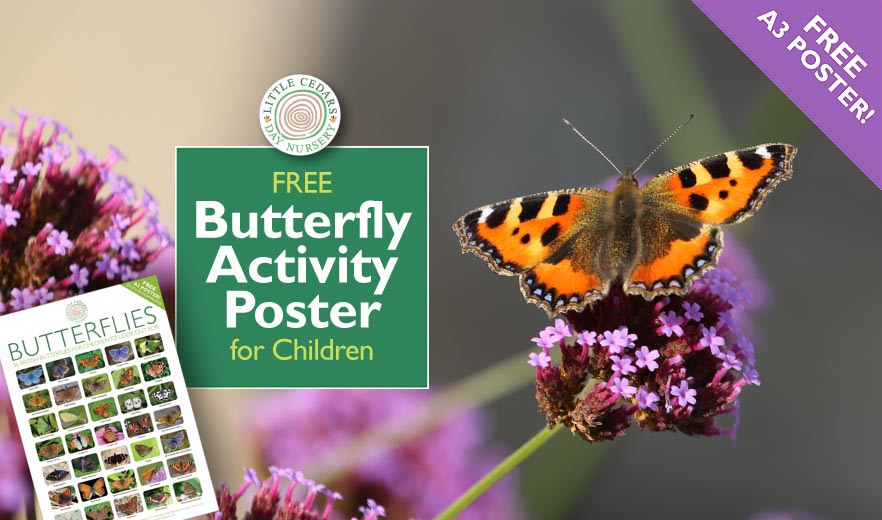
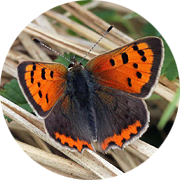 Following on from our bird-spotting article and poster published in March, we now bring you a matching butterfly-spotting activity. Butterflies are both beautiful and adorable. As such, children will love them and will enjoy spending time around them during this activity. Like before, it comes with another free poster for children to print out, display, learn from and enjoy. Butterfly spotting is another wonderful way to get children outdoors to enjoy the fresh air and benefit from everything that nature has to offer.
Following on from our bird-spotting article and poster published in March, we now bring you a matching butterfly-spotting activity. Butterflies are both beautiful and adorable. As such, children will love them and will enjoy spending time around them during this activity. Like before, it comes with another free poster for children to print out, display, learn from and enjoy. Butterfly spotting is another wonderful way to get children outdoors to enjoy the fresh air and benefit from everything that nature has to offer.
This time around, we showcase 36 beautiful butterflies that can be seen in many parts of Britain. Indeed, that was one of the main criteria we used when deciding which butterflies to include. Having said that, some of the butterflies will be more common than others and we really don’t expect every child to spot all 36 butterflies that are featured — although it’s possible if they’re patient and adventurous! It’s a lovely challenge for children, though, and spotting such beautiful creatures may begin to instil in them an appreciation of nature and all the amazing creatures within it. That would be a good thing because nature is more under threat than ever and children of today will eventually become custodians of Britain’s phenomenal natural environment. Nature will also benefit children in many profound ways, including spiritually and even academically.
Free Butterfly Poster
Download Instructions
View the poster in the greatest detail onscreen by clicking the big image above or, with some web browsers, you may need to first download it by right-clicking and then saving. Then view it in Acrobat Reader, which is available free. From Acrobat, print out the poster at full size (A3) or choose ‘reduce to fit’ if your printer is only A4. We recommend using high-quality printing paper and the highest settings for the best results, glorious colour, and the finest detail.
Attract butterflies by putting out fruit wedges — they love the sugary taste of ripe oranges, grapefruits, nectarines, bananas, strawberries and apples!
Shown on the poster are some of the more commonly-known butterflies like Large Whites, Peacocks, Red Admirals and Small Tortoiseshells. However, children may also spot some lesser-known butterflies like Purple Emperors, Orange Tips, Green Hairstreaks and Adonis Blues. Butterflies have wonderful names, don’t they? Parents can help younger children with names, as we don’t expect them to be able to read them all if they’re very young. The young will also need supervising outdoors, of course, for their safety.
Look but Don’t Touch the Butterflies
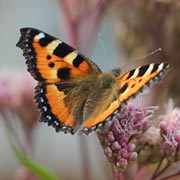 We must also add that children should be encouraged to ‘look but don’t touch’ as butterflies are very delicate creatures. Children should not try to touch or catch them — they are best left in peace as every one of them is a little individual that simply wants to go about his or her day. They’re wonderful to watch, though, and our free poster should help children and adults identify many of the different types. Perhaps see how many different species can be spotted over the course of a year. Take photos too, and compare them with friends! Some butterflies visit gardens, floral window boxes and parks while others may only be found in wilder locations in the countryside. This activity is therefore a great excuse for families to get out and explore The Great Outdoors! Recording the date and location of each butterfly spotted will also help families work out where the best butterfly-spotting locations are for next time.
We must also add that children should be encouraged to ‘look but don’t touch’ as butterflies are very delicate creatures. Children should not try to touch or catch them — they are best left in peace as every one of them is a little individual that simply wants to go about his or her day. They’re wonderful to watch, though, and our free poster should help children and adults identify many of the different types. Perhaps see how many different species can be spotted over the course of a year. Take photos too, and compare them with friends! Some butterflies visit gardens, floral window boxes and parks while others may only be found in wilder locations in the countryside. This activity is therefore a great excuse for families to get out and explore The Great Outdoors! Recording the date and location of each butterfly spotted will also help families work out where the best butterfly-spotting locations are for next time.
Fun fact: Butterflies have taste buds on their feet!
Butterflies are In Decline
Sadly, many butterflies are in decline, with studies reporting a 40% drop in populations in recent decades. That’s really sad, so it’s imperative that they and their precious habitats are not unduly disturbed. Therefore, please do take care. If anything, habitats need to be restored and greater protections put in place. Raising awareness of the plight of butterflies and other creatures in decline, like bees and birds, is therefore something that’s also important for children to be aware of. After all, as they grow older, they will eventually take over stewardship of the natural world and can help to steer decision-makers to improve things if they’ve developed a deep-seated interest in nature by the time they become adults.
The Big Butterfly Count
 With that in mind, why not take this activity a step further and get involved in the UK’s annual Big Butterfly Count? For 2024, it takes place between Friday the 12th of July and Sunday the 4th of August, which is when most butterflies are at their adult stage. All it takes is 15 minutes and children will love being little ‘citizen scientists’! The activity can be done in gardens, parks, school grounds or out in the countryside. Taking part will give children a real opportunity to help with butterfly conservation.
With that in mind, why not take this activity a step further and get involved in the UK’s annual Big Butterfly Count? For 2024, it takes place between Friday the 12th of July and Sunday the 4th of August, which is when most butterflies are at their adult stage. All it takes is 15 minutes and children will love being little ‘citizen scientists’! The activity can be done in gardens, parks, school grounds or out in the countryside. Taking part will give children a real opportunity to help with butterfly conservation.
Learn more about the Big Butterfly Count and to take part here. Our guide includes links to a free smartphone app that will help you/your children during the butterfly counting activity.
A Fun, Educational & Worthwhile Activity for Children
We hope families and children enjoy their butterfly-spotting activities and use our free poster to learn the names. In this way, they can get to recognise some of the different types of butterflies when they spot them when out and about. It’s a fascinating activity and butterflies are both amazingly beautiful and incredibly endearing. As pollinators, they’re extremely important too and represent a barometer for the health of the natural world. Learning more about butterflies and nature is therefore incredibly important and beneficial for children — and ultimately for the planet. So, we encourage children to dive into this activity at the earliest opportunity. Have fun, be gentle and stay safe.
Little Cedars Nursery & Preschool, Streatham, London SW16

 Little Cedars is a high-quality nursery/preschool in Streatham SW16, providing childcare excellence for babies, toddlers and preschoolers under 5 years of age. If you’re looking for a good nursery or preschool for your child, arrange a free tour with us and we’ll show you and your little one around. You’ll be able to get answers to any questions you have and also you’ll see how well your child fits in. Ours is a lovely, welcoming, home-from-home environment where the very best is brought out of every child under our care, so your child will be in good hands. As well as looking after them while parents work or recharge, every child receives an excellent early years education and is prepared for a great start once they leave us to start school. Please choose a button to contact us today, arrange a guided tour or to apply for a place for your child; we’ll be happy to help.
Little Cedars is a high-quality nursery/preschool in Streatham SW16, providing childcare excellence for babies, toddlers and preschoolers under 5 years of age. If you’re looking for a good nursery or preschool for your child, arrange a free tour with us and we’ll show you and your little one around. You’ll be able to get answers to any questions you have and also you’ll see how well your child fits in. Ours is a lovely, welcoming, home-from-home environment where the very best is brought out of every child under our care, so your child will be in good hands. As well as looking after them while parents work or recharge, every child receives an excellent early years education and is prepared for a great start once they leave us to start school. Please choose a button to contact us today, arrange a guided tour or to apply for a place for your child; we’ll be happy to help.
Little Cedars Nursery: high-quality childcare services in Streatham, near Furzedown, Tooting, Balham, Norbury and Colliers Wood
Little Cedars is located in Streatham, just a stone’s throw from Tooting Common and the A214. As well as suiting those families in Streatham and Tooting, we may also be conveniently located for those looking for a nursery or preschool near Streatham Hill, Streatham Park, Streatham Common, Furzedown, Tooting Bec, Tooting Broadway, Balham, Norbury or Colliers Wood.

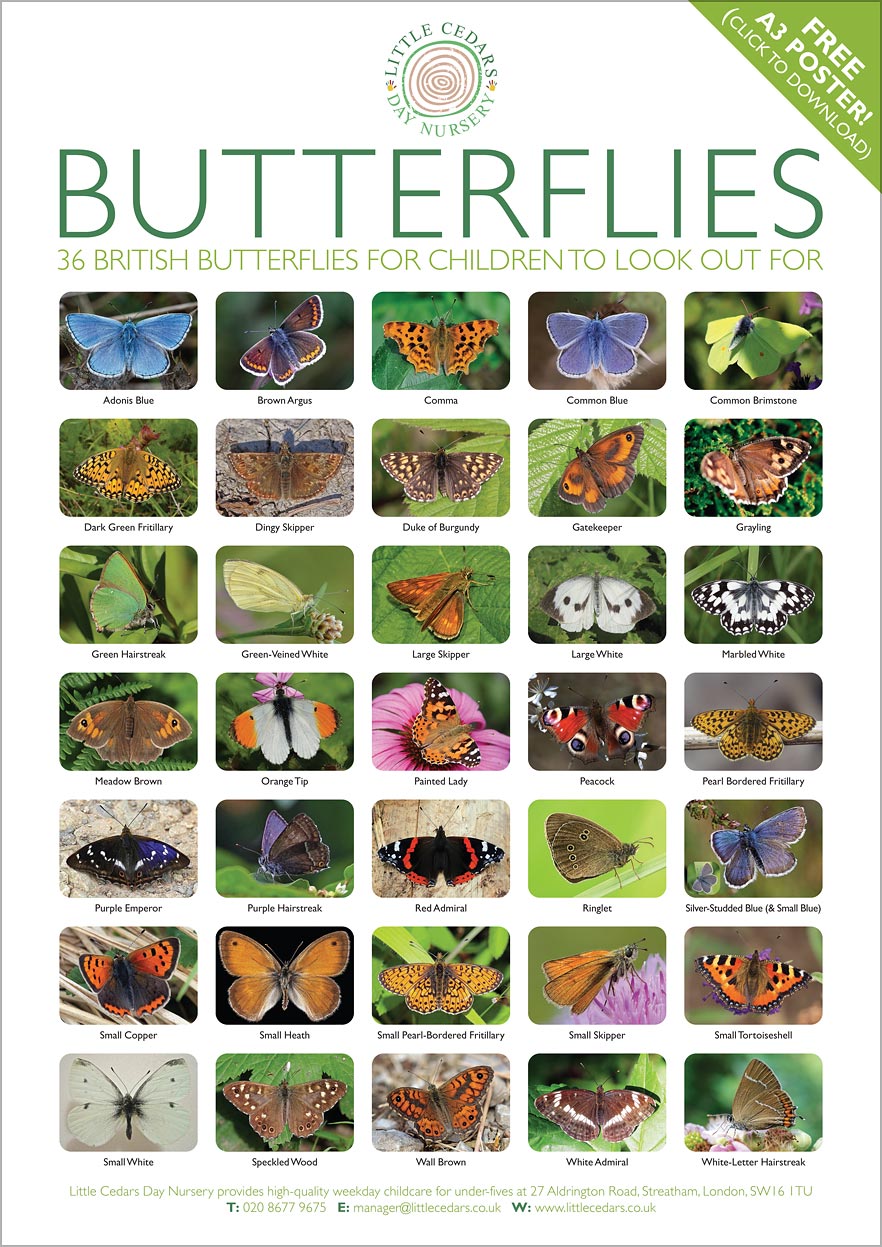
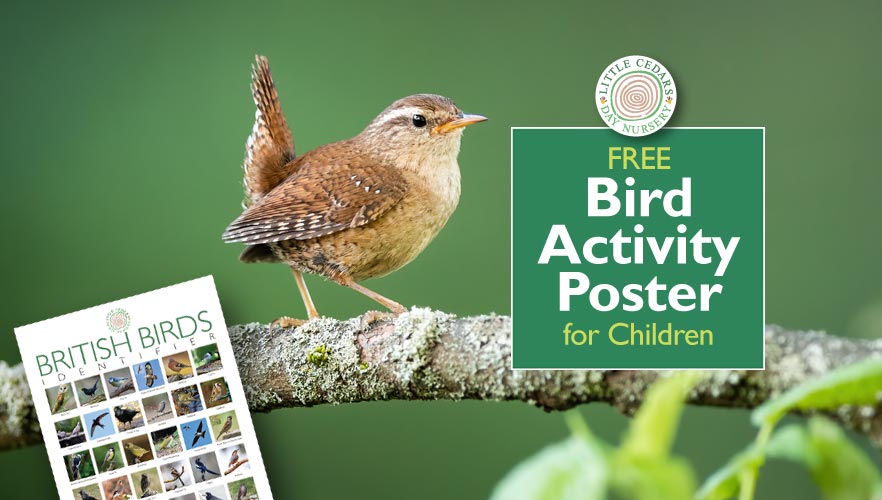
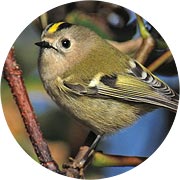 Spring arrives in the UK on 20th March, according to the meteorological calendar. As well as plants beginning to shoot, daffodils flowering and trees starting to bud, an increased number of wild birds can now be seen too. While a few overwintered here in England, many will have spent winter abroad, where it’s warmer, and only begin to return to the UK once spring begins. So, come springtime, more and more varieties of birds can be spotted — and that’s what today’s post is all about. To encourage children to appreciate, enjoy and learn from nature, we have put together a bird identifier poster that children and parents can download for free, print out to A3 or A4, or view on screen in beautiful high resolution. It highlights 37 species of bird that are popular in England, which children can try to spot as the days and weeks go by. Children can perhaps tick off each type of bird that they spot. With a little help from parents for the youngest children, this activity is a great way to teach them the different bird names and help them to recognise the different types as time goes by. It’s also a great children’s pastime that will encourage them to really appreciate nature. The A3 poster is free to download and share — simply click the preview image below to save or view it in Acrobat PDF format. Enlarge on screen for extra detail or simply print out as large as you can. Children will love this activity and feel a real sense of achievement as they learn more about these wonderful, feathered visitors.
Spring arrives in the UK on 20th March, according to the meteorological calendar. As well as plants beginning to shoot, daffodils flowering and trees starting to bud, an increased number of wild birds can now be seen too. While a few overwintered here in England, many will have spent winter abroad, where it’s warmer, and only begin to return to the UK once spring begins. So, come springtime, more and more varieties of birds can be spotted — and that’s what today’s post is all about. To encourage children to appreciate, enjoy and learn from nature, we have put together a bird identifier poster that children and parents can download for free, print out to A3 or A4, or view on screen in beautiful high resolution. It highlights 37 species of bird that are popular in England, which children can try to spot as the days and weeks go by. Children can perhaps tick off each type of bird that they spot. With a little help from parents for the youngest children, this activity is a great way to teach them the different bird names and help them to recognise the different types as time goes by. It’s also a great children’s pastime that will encourage them to really appreciate nature. The A3 poster is free to download and share — simply click the preview image below to save or view it in Acrobat PDF format. Enlarge on screen for extra detail or simply print out as large as you can. Children will love this activity and feel a real sense of achievement as they learn more about these wonderful, feathered visitors.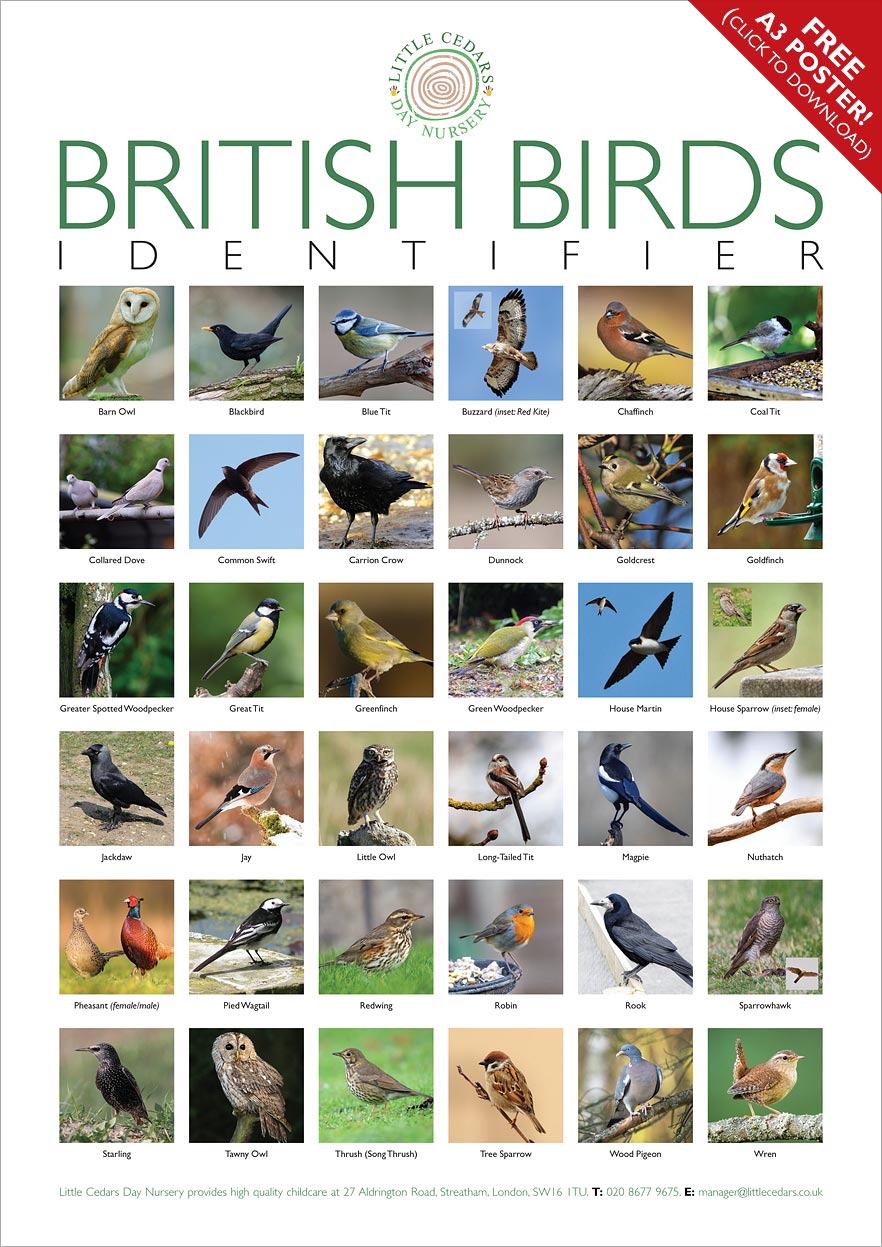
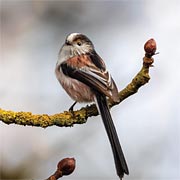 We’ve selected our favourite birds from the hundreds of species that visit the UK each year. There was no way to fit in all of them, so we’ve picked out the most common visitors to our own gardens and nearby parks. In addition, we also added a few extra birds that would be great for children to keep a lookout for, despite a few being shy. Owls are around, for instance, coming out mostly at night. However, barn owls can be seen before dark if you know where to look (the sound of owls hooting or screeching is a dead giveaway). Buzzards, Red Kites and Sparrowhawks are more likely to be seen in the sky overhead, so we’ve shown images where their distinctive silhouettes can give their species away to the onlooker.
We’ve selected our favourite birds from the hundreds of species that visit the UK each year. There was no way to fit in all of them, so we’ve picked out the most common visitors to our own gardens and nearby parks. In addition, we also added a few extra birds that would be great for children to keep a lookout for, despite a few being shy. Owls are around, for instance, coming out mostly at night. However, barn owls can be seen before dark if you know where to look (the sound of owls hooting or screeching is a dead giveaway). Buzzards, Red Kites and Sparrowhawks are more likely to be seen in the sky overhead, so we’ve shown images where their distinctive silhouettes can give their species away to the onlooker.